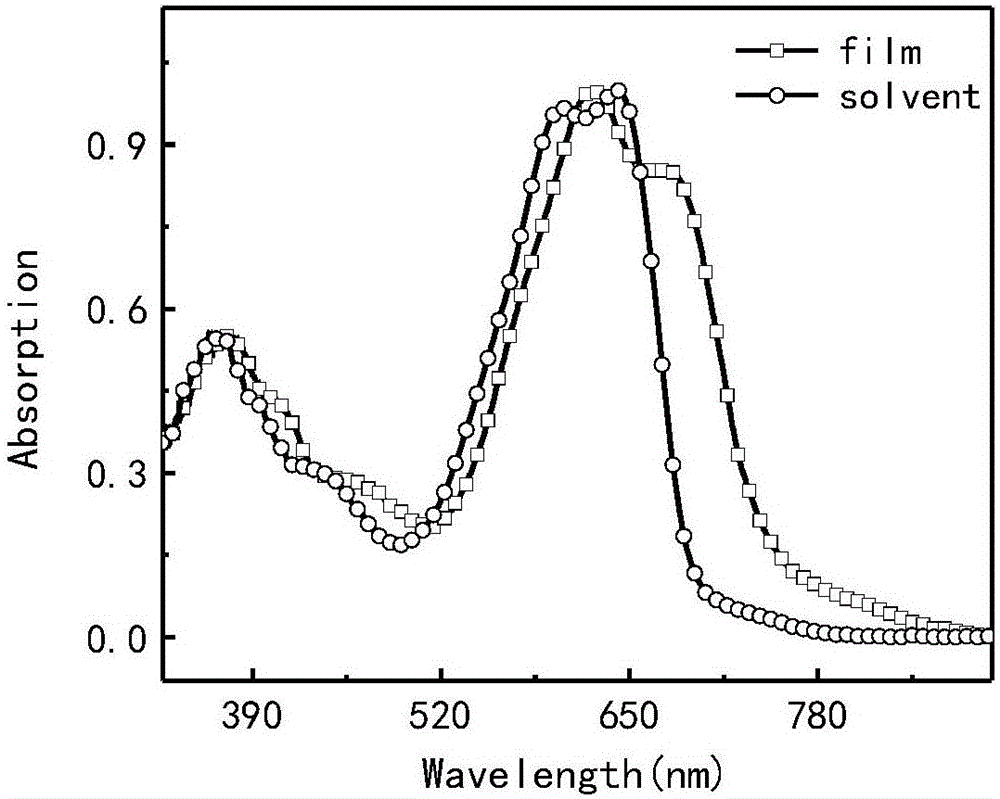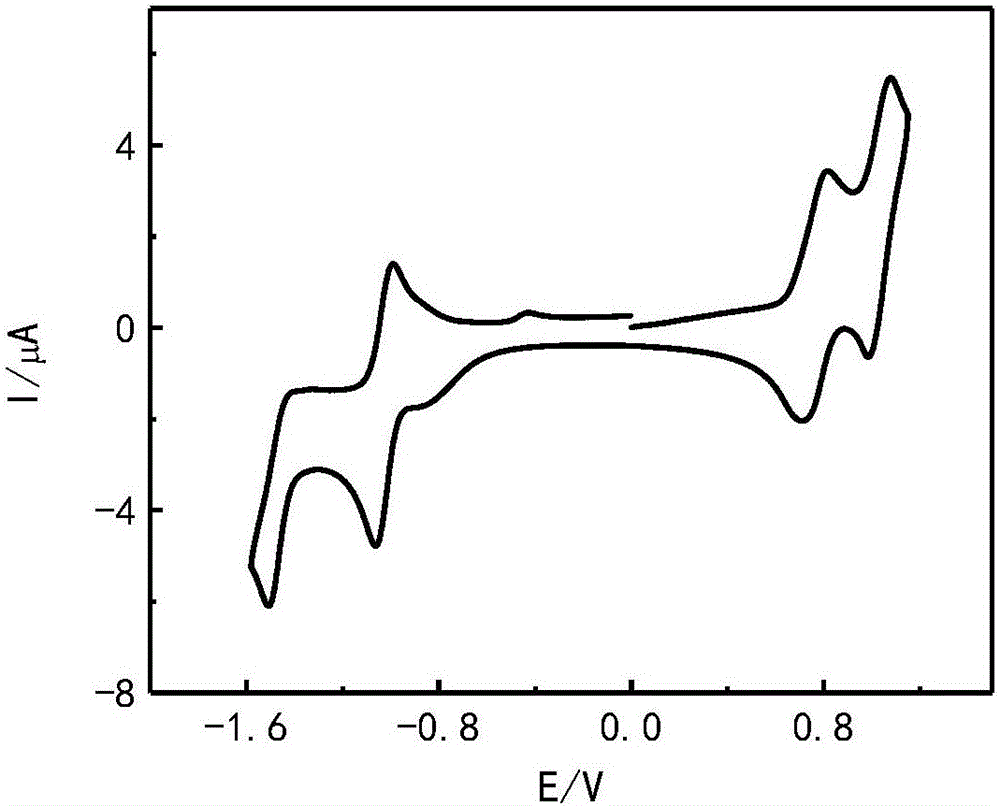Preparation method and application of polycyclic aromatic hydrocarbon K-position imidazolyl-based organic semiconductor materials
A technology of organic semiconductors and polycyclic aromatic hydrocarbons, which is applied in the field of preparation of polycyclic aromatic hydrocarbons based on K-position and imidazole-based organic semiconductor materials, can solve the problem that polycyclic aromatic hydrocarbons materials are rarely used in organic solar cells, etc., to achieve molecular stacking, Great application prospects and good stability
- Summary
- Abstract
- Description
- Claims
- Application Information
AI Technical Summary
Problems solved by technology
Method used
Image
Examples
Embodiment 1
[0033] Example 1. In a single-necked round bottom flask (250mL), add phenanthrenequinone (3g, 14mmol), ammonium acetate (13.98g, 181mmol) and ethanol (100mL), and stir under reflux at 78 degrees. Then, 2-thiophenecarbaldehyde (1.6 g, 14 mmol) was added to the reaction system. After the dropwise addition, continue to stir overnight at 78°C. After the reaction was finished, the ethanol was spin-dried, the solid was washed with water, then suction-filtered, dried, and separated and purified on a silica gel column to obtain 1.48g of 2-(thiophen-2-yl)-1H-phenanthro[9,10-d]imidazole (hereinafter referred to as TPh), producing rate 34.3%. 1 HNMR (400MHz, DMSO) δ (ppm): 8.84 (d, J = 14.1, 8.3Hz, 2H), 8.48 (d, J = 21.5, 7.7Hz, 2H), 7.92 (d, J = 3.6Hz, 1H) , 7.79–7.67 (m, 3H), 7.62 (d, J=6.7Hz, 2H), 7.29–7.24 (m, 1H), 5.74 (s, 1H).
[0034] Add TPh (1.6g, 5.3mmol), potassium carbonate (3.68g, 26.7mmol), potassium iodide (0.044g, 0.3mmol) and N,N-dimethylformamide (hereinafter referre...
Embodiment 2
[0038] Example 2. In a single-necked round bottom flask (250mL), add pyrenedione (4.5g, 19mmol), ammonium acetate (18.8g, 244mmol) and ethanol (100mL), and stir under reflux at 78 degrees. Then, 2-thiophenecarbaldehyde (2.18 g, 19 mmol) was added to the reaction system. After the dropwise addition, continue to stir overnight at 78°C. After the reaction, the ethanol was spin-dried, the solid was washed with water, then suction-filtered, dried, and separated and purified on a silica gel column to obtain 2.15 g of 10-(thiophen-2-yl)-9H-pyreno[4,5-d]imidazole (hereinafter referred to as TPy). The rate is 34.2%. 1 HNMR (400MHz, DMSO) δ (ppm): 8.76 (d, J = 7.5Hz, 1H), 8.70 (d, J = 7.6Hz, 1H), 8.26–8.08 (m, 7H), 7.98 (d, J = 3.6Hz, 1H), 7.74 (d, J = 5.0Hz, 1H), 7.32–7.28 (m, 1H).
[0039] Add TPy (2.0g, 6.2mmol), potassium carbonate (4.3g, 30.9mmol), potassium iodide (0.05g, 0.3mmol) and N,N-dimethylformamide (hereinafter referred to as DMF) (10 mL), stirred at room temperature. ...
Embodiment 3
[0043] Embodiment 3. in two-necked round bottom flask (100mL), add TPh (1.0g, 3.3mmol), potassium carbonate (2.3g, 16.7mmol), potassium iodide (0.028g, 0.17mmol) and N,N-dimethyl form Amide (hereinafter referred to as DMF) (10 mL), stirred at room temperature. Then 1-bromooctane (0.83 g, 4.3 mmol) was added dropwise. After the dropwise addition was completed, the reaction was carried out overnight at room temperature. After the reaction, extract with water and dichloromethane, concentrate, and separate and purify on a silica gel column to obtain 1.1g of 1-octyl-2-(thiophen-2-yl)-1H-phe-nanthro[9,10-d]imidazole (hereinafter referred to as TPh -C 8 ). Yield 80%. 1 HNMR (400MHz, CDCl 3)δ(ppm)8.86–8.82(m,1H),8.80(d,J=7.8Hz,1H),8.69(d,J=8.3Hz,1H),8.29–8.23(m,1H),7.74–7.60 (m,4H),7.58–7.51(m,2H),7.23(dd,J=5.1,3.6Hz,1H),4.76–4.69(m,2H),2.08(d,J=15.6,7.8Hz,2H ), 1.63 (s, 1H), 1.50–1.39 (m, 2H), 1.39–1.21 (m, 9H), 0.88 (d, J=8.8, 5.0Hz, 3H).
[0044] In the reaction flask (50mL...
PUM
 Login to View More
Login to View More Abstract
Description
Claims
Application Information
 Login to View More
Login to View More - R&D
- Intellectual Property
- Life Sciences
- Materials
- Tech Scout
- Unparalleled Data Quality
- Higher Quality Content
- 60% Fewer Hallucinations
Browse by: Latest US Patents, China's latest patents, Technical Efficacy Thesaurus, Application Domain, Technology Topic, Popular Technical Reports.
© 2025 PatSnap. All rights reserved.Legal|Privacy policy|Modern Slavery Act Transparency Statement|Sitemap|About US| Contact US: help@patsnap.com



